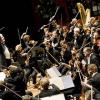Search the Community
Showing results for tags 'structure'.
-
Hi, I'm new here, so forgive me if I'm doing something wrong. I'm writing a sonata-form movement in Romantic style (Schubert, Brahms...). I've written: 1st theme (8+8 bars), ending on i (G min) transition (G min >> Eb) 8 bars of the 2nd theme (starts at bar 57), ending on V (Bb major chord) However, I'm stuck here. :dunno: I've just moved from a classical to a romantic style, and the proportions are bigger. I know I should write something looser and more lyrical here, and it should be roughly 50-60 bars long for balance. I could use more than 1 theme (?), and perfect cadences should be used sparsely. I tend to write very "marked" self-contained themes, like the 1st one, so my initial idea was to write another 8+8 antecedent/consequent. But I can't do this, I must include more material before the V-I and the codetta. Thus, I've written some "continuations" after the 1st 8 bars ending on V, as well as a climax based on that tune, and a little codetta... I don't know how to assemble all that stuff. I've checked out tons examples, but I'm kinda blocked. Any tips? What is your experience? Thanks!! :D
- 2 replies
-
- sonata form
- sonata
-
(and 6 more)
Tagged with:
-
Hi All, I have trouble with writing larger/longer pieces of music. I can come up with melodies or "riffs", but I'm not sure how to make a piece "coherent" and not simply a string of ideas, or a "song", or ABA form. To help me understand, I would like to start with a very simple and short example, prelude in C by Bach, BWv924 (see attached). Why is this piece "coherent"? What is the structure or form of this piece? Thanks for any help IMSLP222728-PMLP180599-Bach_Prelude_BWV924_Cmaj.pdf
- 9 replies
-
- composition
- coherence
-
(and 2 more)
Tagged with:
-
A few years ago I didn't like suites, sonatas... because they seemed boring at the time. As the time went by, I started to realize the inner structure of those forms, and appreciate them more. Most recently, I have became sort of a structure freak, observing relations between sections, movements..., and it does indeed fascinate me. I've also been composing for some time now, but didn't write that much material. Most recently I have firmly set a goal for me, a keyboard suite in c minor. So far, I've written 3 movements, Prelude (presto), Adagio and Scherzo (Allegro assai). The movements yet to be written: Trio, Chorale, Finale. I structured it like this: Prelude (very fast repeating figure going through different harmonies) 2/4 Adagio (as a contrast to the prelude - polyphony in 3 parts) 2/2 Scherzo - Trio - Scherzo d. c. (fast scherzo and relatively slow trio) 3/4 Chorale (slow, hymn - like homophonic four part harmony movement) 4/4 Finale I have a few questions. Please if you're going to answer 'just do whatever you feel is the best', don't even bother writing it. 1. Should at least one movement be completely in a major key (e. g. Trio or Chorale) 2. Is it better for the Finale to be in 6/8 meter and act like a jig so the suite closes like a baroque dance suite, or should I use a rondo form like closing a sonata. 3. I was thinking for some time about adding an 'extra' movement in the middle ('the center movement') between adagio and scherzo. Perhaps a Toccata of some sort, or a rondo movement, but then a jig at the end... Or is it good just the way it is now. I know it is a lot of text here, but... I wanted to be informative. I would have put the first 3 movements up here for you to listen, but I don't have a microphone, and MIDI synthethization is just lame.
-
Hello everyone, I need some help and/or recommended resources/links when it comes to the topics mentioned above, thank you for your time! =)
-
This is a thought that has nagged at me for years now, ever since I started to compose. Let me make it clear, I am not referring to what forms are available on a larger scale (e.g. Concerto, Sting Quartet and so on), nor do I mean how do we handle and develop our themes and ideas – all be this closer to what I mean. I am referring specifically to our use of form and its originality. For example if I say ‘Sonata form’ or ‘Scherzo’, immediately one conjures up a preconception of an inner form – a ‘middle-ground’ form perhaps, if we were to borrow a term from Schenker. Taking a sonata for example, the inner form using the most basic model would be: Exposition (AB-codetta), Development (A’B’), and Recapitulation (AB-coda). However, such middle-ground structures and their subsequent tonal implications seem unsatisfactory in contemporary composition. So, how on this level should we structure music? Obviously some forms are tied to their preconceptions more so than others, the Scherzo for example is little more than a name nowadays rather than form set in stone. On the other hand the sonata despite its many permutations is still a sonata; it is still tied to the concepts of exposition, development, and recapitulation no matter how blurred the boundaries are. Staying strictly within the realms of ‘absolute music’, – i.e. music with no extra-musical connotations such as the tone poem, or other music in which a narrative governs its structure – if the sonata as a form is redundant in 21st century what do we replace it with? As soon as we say this, a whole world of possible alternatives to the sonata opens up. Unfortunately many, (though for different reasons) seem equally unsatisfactory as the sonata. For example, opening a concerto with a (strict) fugue would probably be unsustainable. Using an essentially made up form e.g. ABABACDEBA, lacks the academic rigour required in contemporary composition – at least in this ‘middle-ground’. We could develop forms based upon mathematical principals such as the Golden Ratio, but this is more of an overall form (like the scherzo) and so would leave questions regarding thematic coherence relative to the structure. In short I am at a loss, any suggestions? J





